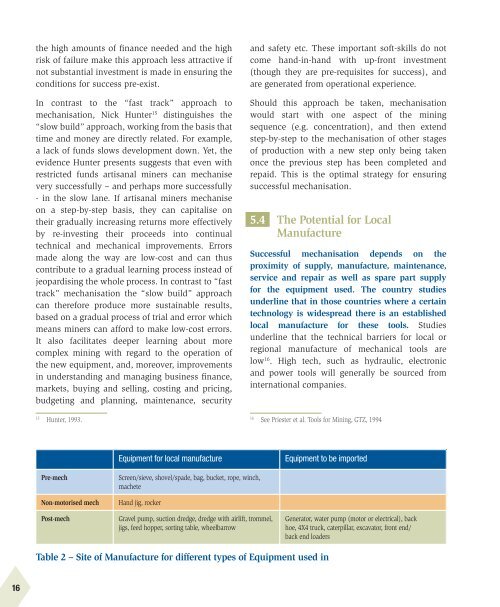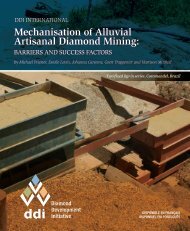Mechanisation-Alluvial-Artisanal-Diamond-Mining
Mechanisation-Alluvial-Artisanal-Diamond-Mining
Mechanisation-Alluvial-Artisanal-Diamond-Mining
Create successful ePaper yourself
Turn your PDF publications into a flip-book with our unique Google optimized e-Paper software.
the high amounts of finance needed and the high<br />
risk of failure make this approach less attractive if<br />
not substantial investment is made in ensuring the<br />
conditions for success pre-exist.<br />
In contrast to the “fast track” approach to<br />
mechanisation, Nick Hunter 15 distinguishes the<br />
“slow build” approach, working from the basis that<br />
time and money are directly related. For example,<br />
a lack of funds slows development down. Yet, the<br />
evidence Hunter presents suggests that even with<br />
restricted funds artisanal miners can mechanise<br />
very successfully – and perhaps more successfully<br />
- in the slow lane. If artisanal miners mechanise<br />
on a step-by-step basis, they can capitalise on<br />
their gradually increasing returns more effectively<br />
by re-investing their proceeds into continual<br />
technical and mechanical improvements. Errors<br />
made along the way are low-cost and can thus<br />
contribute to a gradual learning process instead of<br />
jeopardising the whole process. In contrast to “fast<br />
track” mechanisation the “slow build” approach<br />
can therefore produce more sustainable results,<br />
based on a gradual process of trial and error which<br />
means miners can afford to make low-cost errors.<br />
It also facilitates deeper learning about more<br />
complex mining with regard to the operation of<br />
the new equipment, and, moreover, improvements<br />
in understanding and managing business finance,<br />
markets, buying and selling, costing and pricing,<br />
budgeting and planning, maintenance, security<br />
15<br />
Hunter, 1993.<br />
and safety etc. These important soft-skills do not<br />
come hand-in-hand with up-front investment<br />
(though they are pre-requisites for success), and<br />
are generated from operational experience.<br />
Should this approach be taken, mechanisation<br />
would start with one aspect of the mining<br />
sequence (e.g. concentration), and then extend<br />
step-by-step to the mechanisation of other stages<br />
of production with a new step only being taken<br />
once the previous step has been completed and<br />
repaid. This is the optimal strategy for ensuring<br />
successful mechanisation.<br />
5.4 The Potential for Local<br />
Manufacture<br />
Successful mechanisation depends on the<br />
proximity of supply, manufacture, maintenance,<br />
service and repair as well as spare part supply<br />
for the equipment used. The country studies<br />
underline that in those countries where a certain<br />
technology is widespread there is an established<br />
local manufacture for these tools. Studies<br />
underline that the technical barriers for local or<br />
regional manufacture of mechanical tools are<br />
low 16 . High tech, such as hydraulic, electronic<br />
and power tools will generally be sourced from<br />
international companies.<br />
16<br />
See Priester et al. Tools for <strong>Mining</strong>, GTZ, 1994<br />
Equipment for local manufacture<br />
Equipment to be imported<br />
Pre-mech<br />
Non-motorised mech<br />
Post-mech<br />
Screen/sieve, shovel/spade, bag, bucket, rope, winch,<br />
machete<br />
Hand jig, rocker<br />
Gravel pump, suction dredge, dredge with airlift, trommel,<br />
jigs, feed hopper, sorting table, wheelbarrow<br />
Generator, water pump (motor or electrical), back<br />
hoe, 4X4 truck, caterpillar, excavator, front end/<br />
back end loaders<br />
Table 2 – Site of Manufacture for different types of Equipment used in<br />
16



